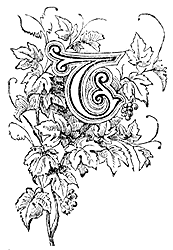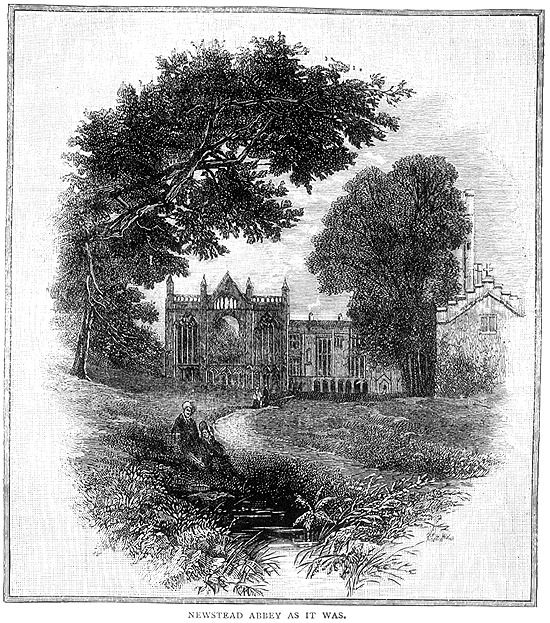 |

HE name of Newstead is associated with one that is immortal as a poet - and whose fate as a man was almost tragic. But it has, also, a claim to be mentioned as the most beautiful ruin in Nottinghamshire.
In the lovely woodlands of this county, within the Forest of Sherwood, I priory of Black or Austin Canons was founded by Henry II., in 1170. He endowed it with the church and town of Papelwick, and a park of ten acres near the town of Mansfield, celebrated as a hunting place of the Plantagenet kings, who visited it to enjoy the pleasures of the chase in Sherwood Forest. We may imagine that Robin Hood and his merry men were anything but pleasant neighbours to the monks of Newstead.
At the dissolution of the monasteries Newstead Priory passed into the possession of the Byrons, an ancient family, holding several manors in Nottinghamshire and Derbyshire, their chief seat being Horistan Castle, in Derbyshire.
Newstead was granted to Sir John Byron in 1540, "with the manor of Papelwick, a rectory of the same, and all the closes about the priory, etc., etc." He fitted up a portion of the monastic buildings as a residence, but the church was let go to decay. Its front is a most beautiful specimen of Early English; the south aisle of the church was built into the mansion, "the western front remained a picturesque ruin," and ranges with the front of the house. The cloisters are quite perfect, and stand nearly in the middle of the building, which is large but irregular. Over the cloisters is a range of galleries, which connect all the rooms, and in these corridors are some perfect suits of armour. The drawingroom is on the upper floor; it is 72 feet long, and has a Gothic roof and plaster compartments, the work, in 1633, Of Italian artists.
On the floor below is a grand dining-hall furnished in the olden style. But a prose description is very inadequate in comparison with the poetical picture that Byron has drawn so vividly himself, and which is so accurate that Sir Richard Phillips walked through and round the abbey with the poem in his hand in 1828, and found the description as correct as one by the dullest architect or antiquary would have been. We give it here:-
 The poet-lord became possessor of Newstead at the age of six years by the death of his uncle. His predecessor had been a man of a haughty and impetuous spirit; and in a duel, which from a dispute between their gamekeepers, he killed his antagonist, Mr. Chaworth, the possessor of the adjoining manor. His youthful successor gave his boyish love to the last descendant of the Chaworth family - the Mary of his poems. "The Dream" contains their history, and the scenery of Newstead is again traceable in the poem. The lady became the wife of Mr. Musters; the poet wedded, was separated, as we know, from his wife, and died at Missolonghi, when about to fight for the liberty of Greece.
Circumstances had compelled him to sell his longdescended inheritance, but happily the purchaser was one who knew and loved the poet. Colonel Wildman was a schoolfellow on the same form as Lord Byron at Harrow, and had an enthusiastic admiration for his gifted acquaintance.
"The house," says Sir Richard Phillips, "is, as it now exists" (1828), "everything that could delight a lover of Byron, an admirer of taste and elegance, and a devotee of antiquity, in close association with our national history and ancient religion. It was an abbey founded by Henry 11., as one of many peace-offerings to the enraged Church, for adding a martyr to its calender, by the sacrifice of the imperious and wily Becket. It was magnificently built in the spirit of the age, and was intended in its structure and endowments to prove the repentance of the politic king. What it was, thanks to Colonel Wildman, it still is; and in Newstead we behold a veritable abbey of the twelfth century, nearly as it was six hundred years ago."
Lord Byron's body was brought to England and buried in Hucknall village church; in the same vault lies his daughter, Lady Lovelace; but his name and fame will always be associated with Newstead Abbey.
|
 |